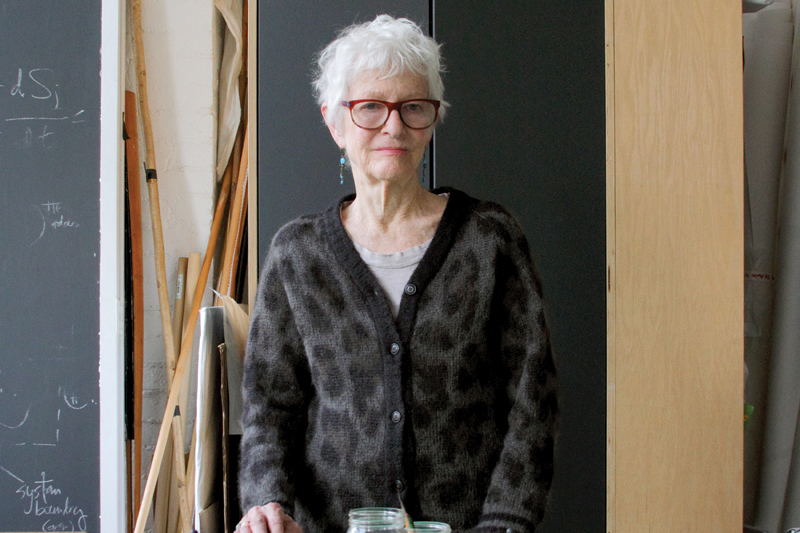Walking down the street towards Joan Jonas’s SoHo loft on a cold December day, I find myself in a high-end shopper’s paradise: Versace, Prada, Balenciaga. Now one of New York’s wealthiest residential neighbourhoods, it is a far cry from the much-mythologised SoHo of the late 1960s and ’70s – a post-industrial enclave whose vast, disused warehouses became a haven for artists. Jonas is a long-time SoHo resident, having first moved to Grand Street in 1968 when, she tells me, ‘artists were just beginning to move in’, before settling into her current home-cum-studio in 1974. ‘It’s changed totally,’ she says of the area, with its dramatic gentrification. ‘There were no shops here, just a bodega on the corner. And it was a little more dangerous than it is now. You had to be very careful at night.’
Light pours through the three west-facing windows of Jonas’s fifth-floor loft, which feels spacious, despite the five tables scattered around it. Drawings, books, exhibition models, CDs, and a cardboard box stuffed with old VHS tapes sit alongside more unusual objects: a tall, twisted twig, straight out of Beckett, rests against a whitewashed brick wall; nearby, placed upon a cupboard, is a bright orange papier-mâché fox head. An array of mirrors are hung together beside a projector screwed to the wall, and a cluster of curated objects includes a day-of-the-dead figurine and a framed picture of a cactus. Poised, with white cropped hair, Jonas looks far younger than her 81 years. She’s in the midst of preparing for a major survey exhibition at Tate Modern, which runs from 14 March to 5 August; talking to me with her energetic poodle Ozu tied to her wrist, she admits to feeling a certain amount of pressure.
Since the late 1960s, Jonas has developed a category-defying practice that incorporates performance, video, installation, drawing, sculpture and sound. Complex and self-reflexive, her work draws on a diverse range of literary sources and relies on a variety of visual props, particularly masks and ritual objects. Long regarded as a pioneer of performance and video art, Jonas has received a heightened level of critical attention in recent years. The Tate exhibition is the largest devoted to the artist in the UK and comes in the wake of her major exhibition in 2014 at HangarBicocca, a former factory space in Milan. In 2015, Jonas also represented the US at the Venice Biennale with the multimedia installation They Come to Us without a Word, widely regarded as a triumph.
They Come to Us without a Word II (2015), Joan Jonas. Performance, Teatro Piccolo Arsenale, Venice, 2015. Photo: Moira Ricci; © 2017 Joan Jonas/ARS, New York/DACS, London
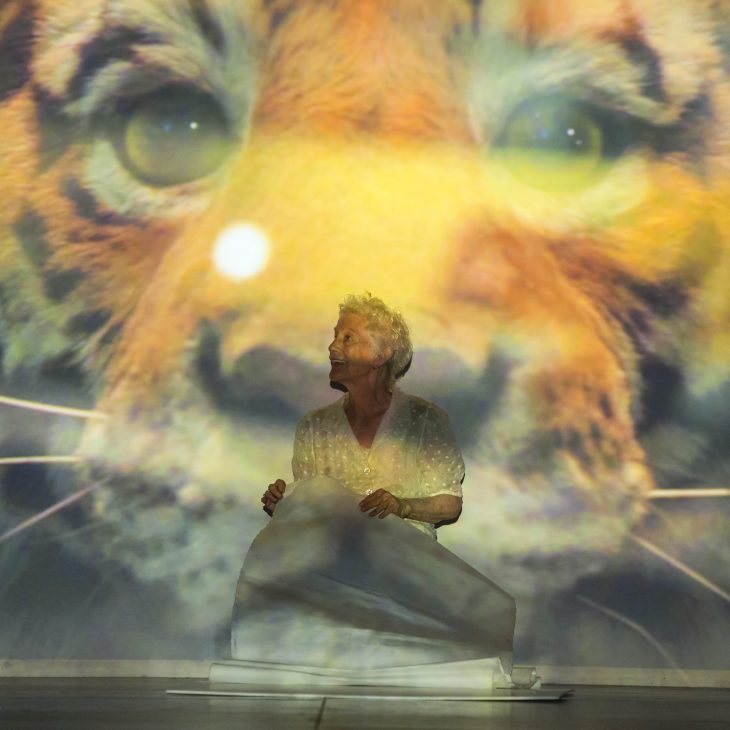
Jonas’s career is grounded in the heady downtown scene of the mid ’60s, a period characterised by its frenetic and hybridised artistic experimentation. Born in New York in 1936, Jonas originally studied art history and sculpture – encouraged by her father – receiving an MFA in sculpture from Columbia University in 1965. She spent time working at Richard Bellamy’s Green Gallery, which introduced her to artists such as Lucas Samaras, Lee Lozano and Donald Judd. Making work heavily influenced by Giacometti, she tells me that she ‘wasn’t really satisfied’ with her practice, and that the diversity of the work she saw downtown left her wanting to explore new forms. ‘It was a very exciting time,’ she recalls in her deep, measured voice, ‘because it seemed like there were all these new things beginning. Most things took place below 14th Street, like concerts by La Monte Young, Philip Glass and Steve Reich, and Claes Oldenburg’s happenings.’
Dance performances by Yvonne Rainer, Trisha Brown, Simone Forti and Deborah Hay had a huge impact in Jonas’s transition from sculpture to live action, as did wider collaborations between dance performers and visual artists. She began taking dance workshops and, despite having no formal theatrical training, was encouraged to explore habitual, everyday movement. For Jonas, shifting into the territory of performance, itself a burgeoning medium, required research into music, dance, sculpture and process-based art. ‘I wanted to develop my own language,’ she tells me – and performance allowed her to invent in new ways, through a use of the body in three-dimensional space. Her desire to go ‘in a different direction’ was ‘partly related to having studied art history, and seeing how artists in the Western tradition are always trying to invent new forms, or new ways of seeing and working’. From 1968 she began performing in lofts, gyms and galleries in lower Manhattan, as well as outdoor spaces, where her audience, mostly made up of friends, ‘was a mixture of people working in different mediums’. ‘It was a very interesting environment, and very supportive,’ Jonas says, giving the impression of a collaborative, intimate scene in which everybody went to see everybody else’s work.
In her early works, Jonas began using the mirror as a prop to explore ideas of reflection, fragmentation and selfhood. Mirror Pieces (1968–70), inspired by the writings of Jorge Luis Borges, featured performers holding large mirrors on stage, slowly rotating them so as to alter conceptions of space and offer shifting reflections of the audience. The mirrors, with which she deliberately attempted to unnerve the viewer, were also, Jonas tells me, about narcissism, and prompted her to consider how people, particularly women, use them. In Mirror Check (1970), Jonas slowly scrutinised her naked body in front of an audience using a small round mirror, in a comment on women’s obsession with self-image.
Mirror Piece I (1969), Joan Jonas. Perfomance, Bard College, New York, 1969. Courtesy the artist and Gavin Brown’s enterprise, New York/Rome
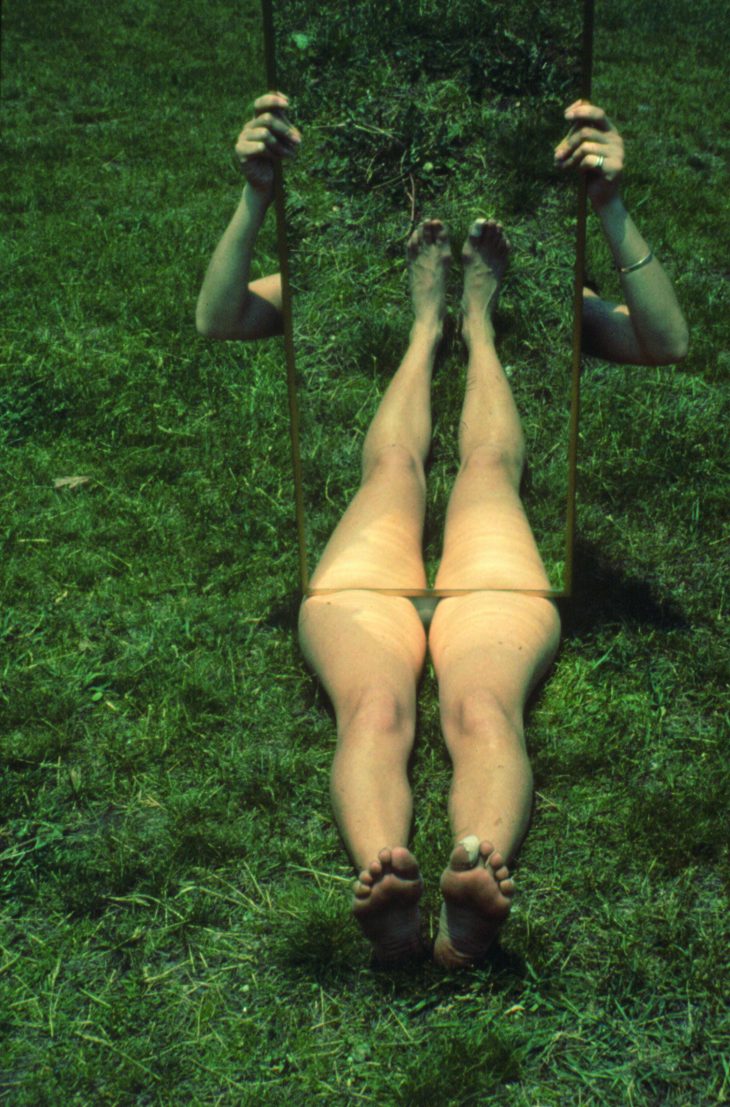
The work of this time that speaks most to a feminist aesthetic is Organic Honey’s Visual Telepathy (1972), one of Jonas’s first video pieces. She bought a Portapak camera on a trip to Japan in 1970, which she describes as ‘a major pivotal moment’, not only because it enabled her to make films in her loft, but also because it changed the way in which she performed. She experimented with a closed-circuit system of camera and monitor, in which she could see herself reflected – Jonas has spoken of seeing the video monitor as another kind of mirror – and she began performing for the camera using a number of props and disguises. In Organic Honey’s Visual Telepathy, Jonas performs both as herself and her masked alter ego Organic Honey. Dressed in a feathery headdress, Organic Honey is portrayed as a seductive temptress, an embodiment of artifice. ‘I was questioning this idea of the female, of what is feminine,’ the artist says.
When I ask her to reflect on what it was like to be a female artist at this time, she is quick to cite the importance of the women’s movement, and especially its impact on her early works, in allowing women new forms of expression and ways of approaching representation. Artistically, ‘it wasn’t that difficult or isolating for me then because I was working in a field in which there were a lot of women,’ Jonas says of the freedom she had found in both performance and video – fields that weren’t dominated by men, unlike more traditional art forms such as painting and sculpture. More broadly, works throughout Jonas’s career, often exploring concepts of alienation, deferral and simultaneity, might be seen to have a feminist sensibility in their resistance to fixed ideas of self or through their focus on archetypes.
Video became a crucial part of Jonas’s performances in the ’70s, allowing her to transmit a live image to a monitor or projector and to move easily between media. Layering the live and the technological – as seen in works such as Funnel (1974) and Mirage (1976), as well as the various performative iterations of Organic Honey – enabled audiences to view different aspects of the work at once, disrupting linear notions of time. But the more radical aspect of the camera in its relationship to the monitor, as Jonas tells me, was ‘that artists could see themselves simultaneously live’. Her understanding of layering techniques, the edit, and the cut came from film – she immersed herself in the history of the medium at Anthology Film Archives – while Renaissance painting influenced her understanding of illusion and framing. The structure of poetry also impacted the way she constructed images. ‘When I began making art, I didn’t see a divide between a poem, a film, a performance, a drawing,’ Jonas says of her collaged approach.
Funnel (1974), Joan Jonas. Performance, University Art Museum, 1974. Courtesy the artist and Gavin Brown’s enterprise, New York/Rome
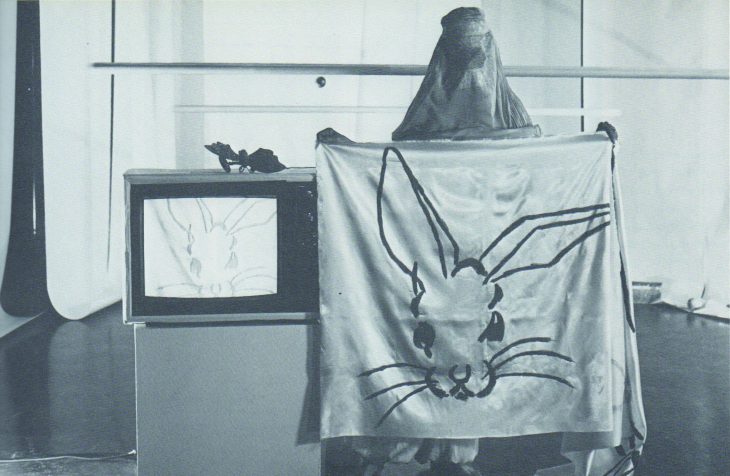
Alongside working with video, Jonas was playing with distance and de-synchronisation in a number of outdoor performances. In Jones Beach Piece (1970), the audience was placed a quarter of a mile away from the performers, who stood at various distances from each other and made loud noises by clapping blocks of wood together in wide arcs above their heads. Similarly, in Delay Delay (1972), the spectators were sited on the roof of a Tribeca loft while the action took place in the empty docks of the Lower West Side. Interested in the effects of distance on perception, Jonas deliberately disrupted the audience’s sense of what was being seen and heard. Song Delay (1973), the film version of these outdoor pieces, with a cast that includes Gordon Matta-Clark, conjures up a vanished New York. The landscape of the Hudson River piers in the 1970s, for example, is unrecognisable today, and the freedom with which Jonas produced these works also belongs to a different time.
Delay Delay (1972), Jonas Jonas. Performance, Lower West Side, New York, 1972. Photo: Gianfrano Gorgoni, 1972; courtesy the artist and Gavin Brown’s enterprise
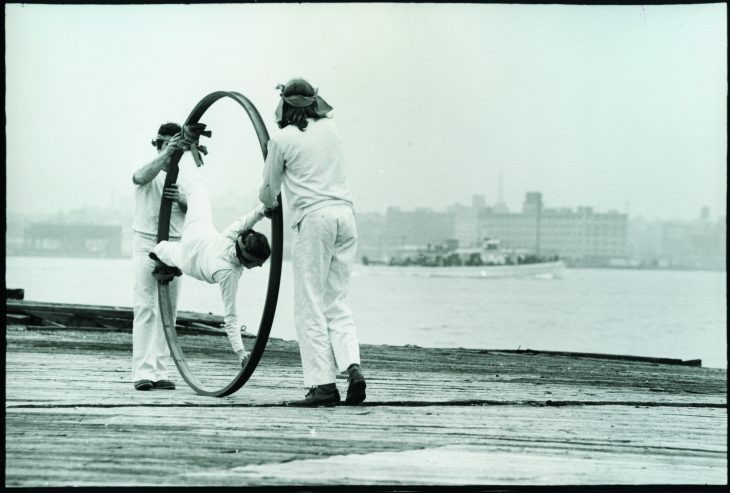
Her use of the mask similarly acts as a distancing device. As an inexperienced performer, she tells me, the mask ‘hid my face, so it wasn’t Joan Jonas performing – it changed the persona […] When you put on a mask everything changes, your body changes, your movements change, and I was interested in that.’ She began using the mask following her trip to Japan, which introduced her to the traditions of Noh theatre, and which inspired her to think about her own art in ritualistic terms. ‘I think of myself as a kind of medium for information to pass through,’ Jonas once said, and her performative gestures can be understood in shamanic terms. In the late ’60s, she travelled to Arizona to see a Hopi Snake Dance, and was later influenced by Aby Warburg’s writings on the ritual – texts that are woven through The Shape, the Scent, the Feel of Things (2005) – identifying with his cross-cultural approach to art history. Her continued desire to work across cultures can be seen in Stream or River, Flight or Pattern (2016–17), which splices footage from travels to Venice, Singapore and Vietnam.
The late ’70s saw Jonas increasingly turn to text. Fairy tales were a particularly fertile resource, with The Juniper Tree (1976), based on the Brothers Grimm story, inspired by a commission to produce a performance for children. By the early ’80s, she had started working with more complex narratives drawing on literary and historical texts, including science fiction (Double Lunar Dogs; 1984), Irish epic poetry (Sweeney Astray; 1992), and Icelandic legend (Volcano Saga; 1989). ‘I refer to literature,’ she says adamantly, ‘but I don’t think my work is literary.’ Jonas approached narrative in non-linear terms, using texts as prompts to create corresponding visual interpretations. ‘In those years, I was really trying to find a way to tell stories, because to tell a story in a video, or an installation, is a totally different discipline. I represent stories in different ways,’ she explains.
Although drawing features as a ritual in earlier works such as Mirage, in which Jonas drew basic geometric shapes with chalk on a blackboard and then erased them, it later assumed a more complex role for her – becoming a physical action often mediated through video, pitting the handmade against the technological. ‘The drawings themselves relate to the subject matter, the space, the content of the performance,’ Jonas tells me, but she makes it clear that ‘drawing is not a performance’. ‘The idea that we have to see the artist making the work is not interesting to me.’ Jonas is also ambivalent about the term performance more generally, and while accepting it is a useful one, she doesn’t like ‘to be seen as a performance artist’ – not least because she views her work more holistically, as ‘a coming together of different forms’.
Mirage (1976), Joan Jonas. Performance, University Art Museum, Berkeley, 1980. Photo: © Benjamin Blackwell; courtesy the artist and Gavin Brown’s enterprise, New York/Rome
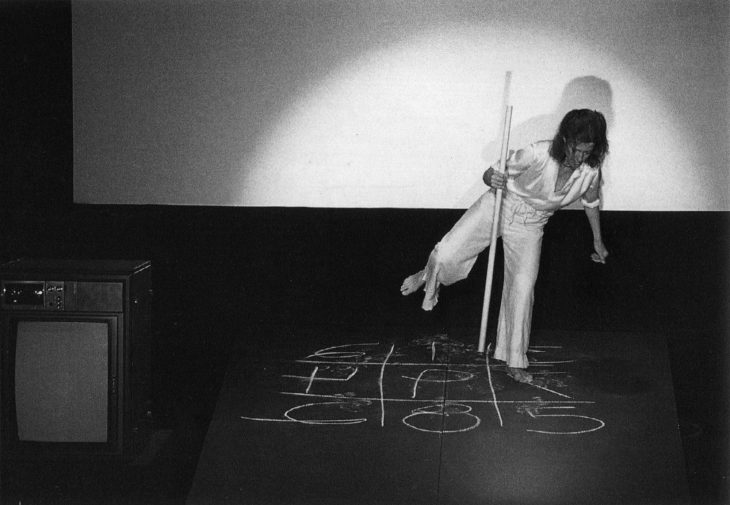
The idea of translation is key to Jonas’s work, which exists in a constant state of transformation. Individual works, whether performances, videos, or installations, do not remain fixed but turn into new works to be restaged at later dates. Elements of individual works can also appear modified in other pieces. For example, her multimedia installation for Venice, They Come to Us without a Word, draws on her earlier performance piece Reanimation, which itself incorporates ghostly footage from Disturbances, a film from 1974. ‘I’m interested in how a different context can alter something,’ she tells me. A retrospective at the Stedelijk, Amsterdam, in 1994 provoked her move towards more elaborate video installations. I wonder whether such layering constitutes a form of personal myth-making. ‘I don’t think of it that way. I would never say I’m a myth-maker,’ she says. Yet this circular approach means Jonas’s vast body of work often feels like a single, multidimensional world.
Place and landscape has always been central to Jonas’s practice, and not only the urban topography of New York City. She has spent part of every summer since 1970 in Nova Scotia, which provides the backdrop to many of her works. It’s also where she collects her antique and found objects – a wide selection of which were displayed at Gavin Brown’s enterprise last year – and her work draws frequently on Cape Breton’s mythology, part of her wider interest in Celtic folklore (Joyce was a very early point of reference). ‘I owe a lot to that area,’ she tells me.
What is found in the windowless house is true (2017), Joan Jonas. Installation view, Gavin Brown’s enterprise, New York, 2017. Courtesy the artist and Gavin Brown’s enterprise, New York/Rome

Jonas’s interest in environmental politics is made clear in recent works that explore our complex relationship with nature. Reanimation, inspired by the novel Under the Glacier (1968) by Icelandic writer Halldór Laxness, is a meditation on melting ice, while They Come to Us without a Word, featuring children and paintings of fish and bees, imagines a world in ecological danger. Her latest performance, Moving Off the Land (2016/17), reflects on the ocean and the life of fish, asking us to consider our shared evolutionary roots with other life forms. More broadly, Jonas’s work focuses on the relationship between animals and humans, and the co-existence of species; the frequent presence of dogs is symbolic of the animal helper that often appears in myth and ritual. In Beautiful Dog (2014), Jonas attaches a GoPro camera to Ozu’s collar as he scampers along a beach, forcing us to view the world from a distant non-human perspective – and often from upside down.
Reanimation (2010), Joan Jonas. Performance at Performa 13, New York, 2013. Photo: © Paula Court; courtesy Museum of Fine Arts, Boston
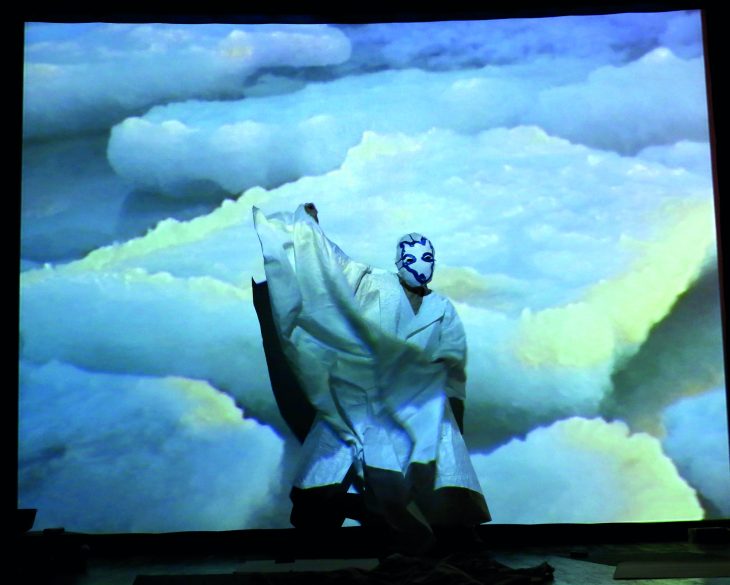
Does she think of herself as a political artist? ‘No. I do refer to politics, but I don’t call myself a political artist.’ She also emphasises the desire for her work to be situated in the present, even if it draws on a historical text. The piles of newspapers dotted around her studio bear witness to her claim that, ‘I’m just naturally reading the paper every day, and tuned into what’s going on, and I think it’s reflected in the work.’ While Lines in the Sand (2002) reworks the myth of Helen of Troy (based on a text by the imagist poet H.D.), its title and date suggest it might be read as a response to the world-changing events of 9/11 and the divisions caused by the war on terror.
Despite the attention she garnered as the US representative in Venice, Jonas has received surprisingly little consideration from US museums; her only large-scale exhibition in New York was at the Queens Museum in 2003–04. The Tate show is another sign of how Jonas’s career is more fully acknowledged in Europe, something that she is hesitant to comment on. As we speak, Jonas is working on a new installation for Tate, telling me that ‘it’s important to make new work’. Alongside the survey, she is also being celebrated as part of the ‘BMW Tate Live Exhibition: Ten Days Six Nights’ (16–25 March), which is staging reimaginings of three early works, including Mirror Check, and a reworking of Delay Delay on the banks of the Thames. It also features a new collaboration with jazz musician Jason Moran, whom she began working with in 2004 and whose improvisations not only ‘inspire me to move in a certain way’, but have also contributed to the more central role sound now occupies in her work. Is she excited about the show? ‘People keep asking me that – I can’t really get excited. I’m superstitious. First it has to work.’
Jonas has been such a consistent presence in her art that it acts as much as a record of her life as one of the spaces in which she has worked. Yet for all her interest in identity and selfhood, she is quick to resist autobiographical readings of her work. ‘It’s a record of my life, as translated into art, but it’s not autobiography.’ It also gives a sense – as does the live element of the Tate show – of Jonas’s tireless dedication to making art across five decades. ‘Once I started, I just couldn’t stop,’ she tells me. ‘I think it has to be an obsession. This is what I had to do – it’s my life.’
‘Joan Jonas’ is at Tate Modern, London, until 5 August.
From the March issue of Apollo. Preview and subscribe here.
